Glasses
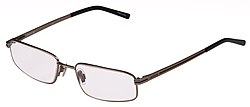
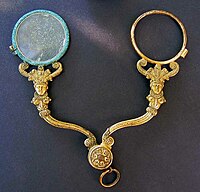
Glasses, also known as eyeglasses (formal), spectacles or simply specs (informal), are frames bearing lenses worn in front of the eyes. They are normally used for vision correction or eye protection. Safety glasses are a kind of eye protection against flying debris or against visible and near visible light or radiation. Sunglasses allow better vision in bright daylight, and may protect against damage from high levels of ultraviolet light. Other types of glasses may be used for viewing visual information (such as stereoscopy) or simply just for aesthetic or fashion purposes.
Historical types of glasses include the pince-nez, monocle, lorgnette, and scissor or scissors-glasses.
Modern glasses are typically supported by pads on the bridge of the nose and by temple arms (sides) placed over the ears. CR-39 lenses are the most common plastic lenses due to their low weight, high scratch resistance, low dispersion, and low transparency to ultraviolet and infrared radiation. Polycarbonate and Trivex lenses are the lightest and most shatter-resistant, making them the best for impact protection.[1]
An unpopular aspect of glasses is their inconvenience. Through modern frames can be both lightweight and flexible, and new lens materials and optical coatings are resistant to breakage or scratching, glasses can still cause problems during rigorous sports. Visibility can be significantly reduced by becoming greasy, trapping vapour when eating hot food, swimming, walking in rain or rapid temperature changes (such as walking into a warm building from cold temperatures outside). Scraping, fracturing, or breakage of the lenses require time-consuming and costly professional repair.
History
Precursors

The earliest historical reference to magnification dates back to ancient Egyptian hieroglyphs in the 5th century BC, which depict "simple glass meniscal lenses". The earliest written record of magnification dates back to the 1st century AD, when Seneca the Younger, a tutor of Emperor Nero of Rome, wrote: "Letters, however small and indistinct, are seen enlarged and more clearly through a globe or glass filled with water".[2] Nero (reigned 54–68 AD) is also said to have watched the gladiatorial games using an emerald as a corrective lens.[3]
The use of a convex lens to form a magnified image is discussed in Alhazen's Book of Optics (1021). Its translation into Latin from Arabic in the 12th century was instrumental to the invention of eyeglasses in 13th century Italy.[2][verification needed]
Englishman Robert Grosseteste's treatise De iride ("On the Rainbow"), written between 1220 and 1235, mentions using optics to "read the smallest letters at incredible distances". A few years later, Roger Bacon is also known to have written on the magnifying properties of lenses in 1262.[4]
Sunglasses, in the form of flat panes of smoky quartz, were used in China in the 12th century.[5] Similarly, the Inuit have used snow goggles for eye protection. However, they did not offer any corrective benefits[6] and the use by historians of the term "sunglasses" is anachronistic before the twentieth century.
Invention of eyeglasses
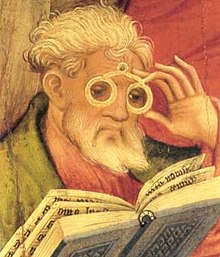
The first eyeglasses were made in Italy at about 1286, according to a sermon delivered on February 23, 1306 by the Dominican friar Giordano da Pisa (ca. 1255 - 1311): "It is not yet twenty years since there was found the art of making eyeglasses, which make for good vision ... And it is so short a time that this new art, never before extant, was discovered ... I saw the one who first discovered and practiced it, and I talked to him."[7] Giordano's colleague Friar Alessandro della Spina of Pisa (d. 1313) was soon making eyeglasses. The Ancient Chronicle of the Dominican Monastery of St. Catherine in Pisa records: "Eyeglasses, having first been made by someone else, who was unwilling to share them, he [Spina] made them and shared them with everyone with a cheerful and willing heart."[8] By 1301, there were guild regulations in Venice governing the sale of eyeglasses.[9]
(Although there have been claims that Salvino D'Armate of Florence invented eyeglasses, these claims have been exposed as hoaxes.[10] Furthermore, although there have been claims that Marco Polo encountered eyeglasses during his travels in China in the 13th century, no such statement appears in his accounts.[11] Indeed, the earliest mentions of eyeglasses in China occur in the 15th century and those Chinese sources state that eyeglasses were imported.[12])

The earliest pictorial evidence for the use of eyeglasses is Tommaso da Modena's 1352 portrait of the cardinal Hugh de Provence reading in a scriptorium. Another early example would be a depiction of eyeglasses found north of the Alps in an altarpiece of the church of Bad Wildungen, Germany, in 1403.
These early spectacles had convex lenses that could correct both hyperopia (farsightedness), and the presbyopia that commonly develops as a symptom of aging. It was not until 1604 that Johannes Kepler published the first correct explanation as to why convex and concave lenses could correct presbyopia and myopia.[13]
Later developments

The American scientist Benjamin Franklin, who suffered from both myopia and presbyopia, invented bifocals. Serious historians have from time to time produced evidence to suggest that others may have preceded him in the invention; however, a correspondence between George Whatley and John Fenno, editor of The Gazette of the United States, suggested that Franklin had indeed invented bifocals, and perhaps 50 years earlier than had been originally thought.[14]
The first lenses for correcting astigmatism were constructed by the British astronomer George Airy in 1825.
Over time, the construction of spectacle frames also evolved. Early eyepieces were designed to be either held in place by hand or by exerting pressure on the nose (pince-nez). Girolamo Savonarola suggested that eyepieces could be held in place by a ribbon passed over the wearer's head, this in turn secured by the weight of a hat. The modern style of glasses, held by temples passing over the ears, was developed some time before 1727, possibly by the British optician Edward Scarlett. These designs were not immediately successful, however, and various styles with attached handles such as "scissors-glasses" and lorgnettes were also fashionable from the second half of the 18th century and into the early 19th century.
In the early 20th century, Moritz von Rohr at Zeiss (with the assistance of H. Boegehold and A. Sonnefeld[15]), developed the Zeiss Punktal spherical point-focus lenses that dominated the eyeglass lens field for many years.
Despite the increasing popularity of contact lenses and laser corrective eye surgery, glasses remain very common, as their technology has improved. For instance, it is now possible to purchase frames made of special memory metal alloys that return to their correct shape after being bent. Other frames have spring-loaded hinges. Either of these designs offers dramatically better ability to withstand the stresses of daily wear and the occasional accident. Modern frames are also often made from strong, light-weight materials such as titanium alloys, which were not available in the earlier times.
Types
Corrective
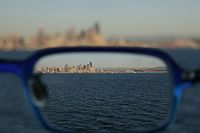
Corrective lenses are used to correct refractive errors of the eye by modifying the effective focal length of the lens in order to alleviate the effects of conditions such as nearsightedness (myopia), farsightedness (hyperopia) or astigmatism. Another common condition in older patients is presbyopia which is caused by the eye's crystalline lens losing elasticity, progressively reducing the ability of the lens to accommodate (i.e. to focus on objects close to the eye).
The power of a lens is generally measured in diopters. Glasses correcting for myopia will have negative diopter strengths, and glasses correcting for hypermetropia will have positive diopter strengths. Glasses correcting for astigmatism require two different strengths placed at right angles in the same lens. Prescription lenses, made to conform to the prescription of an ophthalmologist or optometrist, are used to make prescription glasses, which are then verified correct using a professional lensmeter.
Pinhole glasses are a type of corrective glasses which do not use a lens and are claimed to help correct the eye's refractive error without introducing the image distortion of traditional lens-based glasses. Pinhole glasses do not actually refract the light or change the focal length, they operate by reducing the size of the blur circles in the retinal images. In blurry vision, every point on the object corresponds with a blur circle in the image. By reducing the size of the blur circles, they reduce the overlap of the blur circles in the image, clarifying the vision somewhat. They do not heal the eye of refractive error, as sometimes claimed, and vision with pinhole glasses, although clearer than without them, is not as clear as with conventional lenses.
Correcting one's vision is done by using lenses to move the focal point on the retina accordingly with one's particular needs. The depth of the curve, the thickness of the lens, and the precise shape of the lens can all be used to change the focal point.[16]

Eyeglasses can normally correct and compensate for four types of vision deficiencies:
- Myopia is a vision disorder that causes far objects to appear blurred but near objects are seen clearly.[17] Individuals suffering from myopia are prescribed eyeglasses with concave lenses, which compensate for the refraction error by moving the image of the distant objects that cannot be seen clearly backward onto the retina.
- Correcting hyperopia is normally done with eyeglasses with convex lenses. With this disorder, the patients can see distant objects clearly but they have trouble with seeing objects that are close to them. Eyeglasses with convex lenses compensate for the refraction errors by moving the image of a distant object forward onto the retina.[17]
- Astigmatism is typically corrected with a cylindrical lens. This disorder is caused by a non-uniform curvature in the refractive surfaces of the eye, which leads to an abnormality in focusing the light rays on the retina. As a result, a part of the light rays are focused on the retina and the other part is focused behind it or in front of it.
- Presbyopia is a condition where the eye exhibits a progressively diminished ability to focus on near objects with age. It is more frequent in people over 40 years old and it is corrected with convex lenses. These patients need reading or bifocal eyeglasses.
Corrective eyeglasses can significantly improve the life quality of the patient as they are helpful in both correcting vision disorders and reducing problems that appear when such lenses are needed, such as headaches or squinting.
Corrective lenses can also be added to work masks or eyeglasses which are used in sports.
Eyeglass lenses are commonly made from plastic, including CR-39 and polycarbonate. These materials reduce the danger of breakage and weigh less than glass lenses. Some plastics also have more advantageous optical properties than glass, such as better transmission of visible light and greater absorption of ultraviolet light.[1] Some plastics have a greater index of refraction than most types of glass; this is useful in the making of corrective lenses shaped to correct various vision abnormalities such as myopia, allowing thinner lenses for a given prescription. Newer plastic lenses, called iZon, can also correct for the symptoms of the higher order aberrations that naturally occur on a person's optical system (including retina, lens, and cornea).[citation needed] These lenses create sharper vision for people who have problems with blurry or dull vision, as well as help reduce the halos, starbursts, and comet-tails often associated with night time driving.[citation needed]
Scratch-resistant coatings can be applied to most plastic lenses giving them similar scratch resistance to glass. Hydrophobic coatings designed to ease cleaning are also available, as are anti-reflective coatings intended to reduce glare, improve night vision and make the wearer's eyes more visible.[18]
Safety
Safety glasses are usually made with shatter-resistant plastic lenses to protect the eye from flying debris. Although safety lenses may be constructed from a variety of materials of various impact resistance, certain standards suggest that they maintain a minimum 1 millimeter thickness at the thinnest point, regardless of material. Safety glasses can vary in the level of protection they provide. For example, those used in medicine may be expected to protect against blood splatter while safety glasses in a factory might have stronger lenses and a stronger frame with additional shields at the temples to protect from sawdust, flying wood, or metal. The lenses of safety glasses can also be shaped for correction.
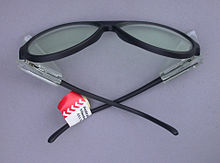
The American National Standards Institute has established standard ANSI Z87.1 for safety glasses in the United States, and similar standards have been established elsewhere.
OSHA provides guidance on the type of safety eyewear that should be used for a particular application.
Some safety glasses are designed to fit over corrective glasses or sunglasses. They may provide less eye protection than goggles or other forms of eye protection, but their light weight increases the likelihood that they will actually be used. Modern safety glasses tend to be given a more stylish design in order to encourage their use. Corrective glasses with plastic lenses can be used in place of safety glasses in many environments; this is one advantage that they have over contact lenses.
There are also safety glasses for welding, which are styled like wraparound sunglasses, but with much darker lenses, for use in welding where a full sized welding helmet is inconvenient or uncomfortable. These are often called "flash goggles", because they provide protection from welding flash.
Worker safety eyewear is available in various lens colors and/or with coatings to protect or enable eyesight in different lighting conditions, particularly when outdoors.
Nylon frames are usually used for protection eyewear for sports because of their lightweight and flexible properties. They are able to bend slightly and return to their original shape instead of breaking when pressure is applied to them. Nylon frames can become very brittle with age and they can be difficult to adjust.
Safety lenses are usually made of polycarbonate.[19] Polycarbonate and Trivex lenses are the lightest and most shatter-resistant, making them the best for impact protection,[1] though polycarbonate offers poor optics due to high dispersion, having a low Abbe number of 31. Safety glasses are also available in prescription form for those persons who need corrective lenses.[20] Depending on the particular area in which the individuals work, they may be required to wear side protectors additionally to safety eyeglasses.
In order to comply with the ANSI Z87.1 requirements, safety eyeglasses must pass the high velocity and high mass tests. Also, the lenses of protective goggles, faceshield windows and welding filters cannot be thinner than 3 mm excepting the high impact lenses which are meant to be installed in prescription frames which cannot be thinner than 2 mm.
Sunglasses

Sunglasses may be made with either prescription or non-prescription lenses that are darkened to provide protection against bright visible light and, possibly, ultraviolet (UV) light. Photochromic lenses, which are photosensitive, darken when struck by UV light.
Light polarization is an added feature that can be applied to sunglass lenses. Polarization filters remove horizontally polarized rays of light, which eliminates glare from horizontal surfaces (allowing wearers to see into water when reflected light would otherwise overwhelm the scene). Polarized sunglasses may present some difficulties for pilots since reflections from water and other structures often used to gauge altitude may be removed, or instrument readings on liquid crystal displays may be blocked.
Yellow lenses increase color contrast and improve depth perception. They are worn by people driving at dusk, but are detrimental to vision at night. Any tint further reduces incoming light to the retina, and yellow tints also reduce glare-recovery times for night drivers.[21] Brown lenses are common among golfers, but cause color distortion. Blue, purple, and green lenses offer no real benefits to vision enhancement, and are mainly cosmetic.[citation needed] Some sunglasses with interchangeable lenses have optional clear lenses to protect the eyes during low light or night time activities and a colored lens with UV protection for times where sun protection is needed.
Sunglasses are often worn just for aesthetic purposes, or simply to hide the eyes. Examples of sunglasses that were popular for these reasons include teashades and mirrorshades. Many blind people wear opaque glasses to hide their eyes for aesthetic reasons.
3D glasses
The illusion of three dimensions on a two dimensional surface can be created by providing each eye with different visual information. 3D glasses create the illusion of three dimensions by filtering out the light not intended for that eye, resulting in each eye receiving a different image. The traditional anaglyph 3D glasses have one red lens and one blue or cyan lens. Another kind of 3D glasses uses polarized filters, with one lens using clockwise circular polarization and the other anti-clockwise, with the two images required for stereo vision polarized the same way. Circular polarization is used so the image separation is maintained even if the viewer tilts their head (although the depth effect will suffer as the head tilt increases), which would not be possible with the more usual linear polarizers. Polarized 3D glasses allow for color 3D, while the red-blue lenses produce a dull black-and-white picture with red and blue fringes. Both types have been distributed to audiences at 3D movies.
One kind of electronic 3D spectacles uses electronic shutters, while virtual reality glasses and helmets have separate video screens for each eye. A 3D effect can also be produced using LCD shutter glasses.[22]
Ready-made reading glasses
Magnifying lenses or generic spectacles that are used to treat mild presbyopia and hyperopia can be bought off the shelf. Although such glasses are generally considered safe, an individual prescription, as determined by an ophthalmologist or optometrist and made by a qualified optician, usually results in better visual correction and fewer headaches & visual discomfort. There have also been many cases where people have delayed having a proper eye examinaton with an optometrist or ophthalmologist, preferring to purchase off the shelf glasses, who have put their sight at risk from conditions such as AMD, glaucoma and complications from diabetes.[citation needed] It is important to stress off the shelf readers are not a replacement for regular eye examinations.
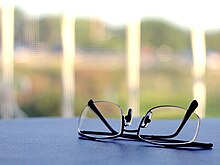
Reading glasses come in two main styles: full frames, in which the entire lens is made in the reading prescription, and half-eyes, the smaller "Ben Franklin" style glasses that sit lower down on the nose.[23] Ready made reading glasses are available in strengths ranging from 1.00 to 3.50[24]
Full reading glasses are more suitable for people who only need them for close-up reading while half-eye reading glasses can be used to read at smaller or larger distances. The reading glasses are most of the time needed by people who have never worn glasses.
Although specialists recommend individuals who need to wear eyeglasses to have them custom-made according to their own needs, most of the patients prefer buying them at a pharmacy or department store. This type of eyeglass-shopping became very popular in the 1990s when it was estimated that over 30 million pairs were sold per year. These reading glasses are not as expensive as the custom-made ones and they are certainly designed to catch the buyer's eye. Glasses that can be purchased off the shelf are available in a wide variety of colors and designs, suitable for different tastes. As this habit can result in worsening one's vision problems[citation needed], there is a new alternative to buy eyeglasses easy and cheap from online prescription eyeglasses stores.[25]
One downside of ready-made eyeglasses is that their prescription is the same for each eye. The optical center of each lens is also the same. Yet, most individuals who need reading glasses need different prescriptions in each eye. Wearing ready-made eyeglasses can result in headaches, eyestrain or nausea, and these "side effects" increase with the extent of the prescriptions' mismatch. Another disadvantage is that people with a strong prescription will not find ready-made solutions. They usually cannot be found with spherical corrections greater than plus or minus three dioptres, and of course are never corrected for astigmatism. Some feel that it would be possible to obtain a cheap frame for their existing lenses by first purchasing ready-mades; while this may be possible for some, the problem with the idea is twofold; there is no standard for lens shapes, so without resorting to extreme fitting methods like glue, it is unlikely that the right fitting could be found; the ready-mades themselves might have their existing lenses glued in place, so could be difficult to remove.
Bifocals, trifocals, and progressive lenses
As people age, their ability to focus is lessened and many decide to use multiple-focus lenses, which can be bifocal or even trifocal, to cover all the situations in which they use their sight. Traditional multifocal lenses have two or three distinct horizontal viewing areas, each requiring a conscious effort of refocusing. Some modern multifocal lenses, such as progressive lenses (known as "no-line bifocals"), give a smooth transition between these different focal points, unnoticeable by most wearers, while other glasses have lenses specifically intended for use with computer monitors at a fixed distance. People may have several pairs of glasses, one for each task or distance, with specific glasses for reading, computer use, television watching, and writing.[citation needed]
Extreme magnification (bioptics)
A form of glasses with extreme magnification to improve the distance vision of those with severe eyesight impairment, especially people with albinism, are known as bioptics or a bioptic telescope. They may take the form of self-contained glasses that resemble goggles or binoculars, or may be attached to existing glasses.
Fashion
Personal image
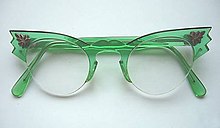

Glasses can be a major part of personal image and expression, from Groucho Marx and Buddy Holly to the extravagance of Elton John and Dame Edna Everage.
Eyewear became a fashion accessory in the 1950s.[26] Browline glasses were the standard for men in the 1950s and 1960s.
For some celebrities, glasses form part of their identity. United States Senator Barry Goldwater continued to wear lensless horn-rimmed glasses after being fitted with contact lenses because he was not recognizable without his trademark glasses. British soap star Anne Kirkbride had the same problem: her character on Coronation Street, Deirdre Barlow, became so well-known for her big frames that she was expected to wear them at social gatherings and in international tours, even though Kirkbride has always worn contact lenses. Comedian Drew Carey continued to wear glasses for the same reason after getting corrective laser eye surgery. British comedic actor Eric Sykes, who became profoundly deaf as an adult, wears glasses that contain no lenses; they are actually a bone-conducting hearing aid. Masaharu Morimoto wears glasses to separate his professional persona as a chef from his stage persona as Iron Chef Japanese. John Lennon wore his round-lens 'Windsor' spectacles from some of his time with the Beatles to his murder in 1980. The rock band Weezer is known for some of the members' wearing thick-rimmed glasses, as well as actor Jeff Goldblum who is often seen in the Browline glasses style. Singer Anastacia, who dominated the European charts in the early 21st century, is noted for wearing odd coloured glasses.
In popular culture, glasses were all the disguise Superman and Wonder Woman needed to hide in plain view as alter egos Clark Kent and Diana Prince, respectively.
Styles
20th and 21st Century
A rare and currently noncommercial variation are rimless and frameless glasses attached to a piercing at the bridge of a wearer's nose.[27] Such glasses have the visual look of the pince-nez.
Glazing
Spectacle lenses are edged into the frame's rim using glazing machines operated by ophthalmic technicians. The edging process begins with a trace being taken of the frame's eye shape. In earlier days the trace was replicated onto a plastic pattern called a former. Nowadays the process is patternless and the shape is sent to the edger electronically.
The lens, in the form of an uncut surfaced and polished lens which mostly comes in a round shape- but can be square as for the executive bifocal- and which maybe mass produced as in single vision lenses, or specially ordered for the other forms, is positioned at a clamping point in the correct manner manually or as it happens now by the computer to match the prescription. A block is then stuck to the lens and that block fits into a chuck in the edging machine. A diamond-coated wheel spins as the edger replicates the uncut lens to the frame's eye-shape. An inverted V-shaped bevel is applied to allow the edge of the lens to fit into the frame's grooved rim. But the edges can be different for the rimless frames.
Redistribution
Some organizations like Lions Clubs International,[28] Unite For Sight[29] and New Eyes for the Needy provide a way to donate glasses and sunglasses. Unite For Sight has redistributed more than 200,000 pairs.[30]
See also
References
- ^ a b c DeFranco, Liz (2007). "Polycarbonate Lenses: Tough as Nails". All About Vision. Retrieved 2007-09-01.
{{cite web}}: Unknown parameter|month=ignored (help) - ^ a b Kriss, Timothy C.; Kriss, Vesna Martich (April 1998). "History of the Operating Microscope: From Magnifying Glass to Microneurosurgery". Neurosurgery. 42 (4): 899–907. doi:10.1097/00006123-199804000-00116. PMID 9574655.
- ^ Pliny the Elder. "Natural History". Retrieved 2008-04-27.
- ^ "....Optics Highlights: II. Spectacles". University of Maryland, Department of Electrical & Computer Engineering. Retrieved 2007-09-01.
- ^ Joseph Needham, Science & Civilisation in China (Cambridge, England: Cambridge University Press, 1962), volume IV, part 1, page 121. Needham states that dark glasses were worn by Chinese judges to hide their facial expressions during court proceedings.
- ^ Ament, Phil (2006-12-04). "Sunglasses History - The Invention of Sunglasses". The Great Idea Finder. Vaunt Design Group. Retrieved 2007-06-28.
- ^ Vincent Ilardi, Renaissance Vision from Spectacles to Telescopes (Philadelphia, Pennsylvania: American Philosophical Society, 2007), page 5.
- ^ Ilardi (2007), page 6.
- ^ Ilardi (2007), page 9.
- ^ (1) Edward Rosen (1956) "The invention of eyeglasses," Journal of the History of Medicine and Allied Sciences, volume 11, pages 13-46 (part 1) and 183-218 (part 2); (2) Vincent Ilardi, Renaissance Vision from Spectacles to Telescopes (Philadelphia, Pennsylvania: American Philosophical Society, 2007), pages 13-18.
- ^ (1) Joseph Needham, Science & Civilisation in China (Cambridge, England: Cambridge University Press, 1962), volume IV, part 1, page 119, footnote c; (2) Julius Hirschberg, "Geschichte der Augenheilkunde" (History of Ophthamology), page 265 in Alfred K. Graef and Theodor Saemisch, ed.s, Handbuch der gesamten Augenheilkunde [Handbook of all ophthalmology] (Leipzig, Germany: Wilhelm Engelmann, 1911), volume 13.
- ^ Joseph Needham, Science & Civilisation in China (Cambridge, England: Cambridge University Press, 1962), volume IV, part 1, page 119.
- ^ In his treatise Ad Vitellionem paralipomena [Emendations (or Supplement) to Witelo] (1604), Kepler explained how eyeglass lenses compensate for the distortions that are caused by presbyopia or myopia, so that the image is once again properly focused on the retina. See: (1) Ilardi (2007), page 244 ; and (2) Vasco Ronchi with Edward Rosen, trans. Optics: The Science of Vision (Mineola, New York: Dover Publications, Inc., 1991), pages 45-46.
- ^ "The 'Inventor' of Bifocals?". The College of Optometrists.
- ^ "Eyeglass Lenses and Visual Aids from Industrial Production". Zeiss.com. Retrieved 2007-09-02.
- ^ "What are Corrective Lenses?". Retrieved 2010-06-14.
- ^ a b "Eyeglasses Prescription Eyeglasses". Retrieved 2010-06-14.
- ^ DeFranco, Liz (2006). "Do You Need Lens Coatings?". All About Vision. Retrieved 2007-09-01.
{{cite web}}: Unknown parameter|month=ignored (help) - ^ "Safety Glasses and Eye Safety Q&A". Retrieved 2010-06-14.
- ^ "Choosing and Using Eye Protection". Retrieved 2010-06-14.
- ^ "Dangerous Misconceptions of Night-Driving Lenses". Laramy K Optical. April 2009.
- ^ "Technologies for Consumer 3D Anatomical Interactivity". OCB Media. 1 October 2008. Retrieved 2009-01-26.
- ^ "Reading Glasses". Retrieved 2010-06-14.
- ^ "Reading Glasses Strength". Retrieved 2010-06-14.
- ^ "Optical Eyeglasses Prescription Frames". Retrieved 2010-06-14.
- ^ Pauline Weston Thomas. "1950s Glamour with Fifties Accessories - Fashion History". Retrieved September 17, 2010.
- ^ "Pierced Glasses". Retrieved 2007-08-07.
- ^ Lions Clubs International. "Lions Eyeglasses Recycling Facts " received 20 August 2008.
- ^ Unite For Sight "Donate Eyeglasses and Sunglasses" received on 20 August 2008.
- ^ "2007 BRICK Award Winner: Jennifer Staple" HowStuffWorks 20 February 2007, received 20 August 2008.
External links
- British Optical Association Museum, Spectacles Gallery
- The Medieval Technology Pages
- Are Your Eyes Right February 1944 Popular Science article on eyes and how eyeglasses correct vision
